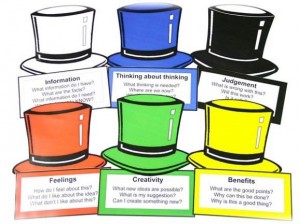Solve Problems by Wearing Hats
Six Thinking Hats (de Bono, Edward (1985). Six Thinking Hats: An Essential Approach to Business Management) is a great process to explore problems or issues either as a team or alone. We all have preferences in the way we think but exploring other styles of thinking can enrich our thinking and fill any gaps in our thinking process.
De Bono identified six distinct directions in which the brain can be challenged to think. Coloured hats are used as metaphors for each direction. Switching to a direction is symbolised by the act of putting on a coloured hat, either literally or metaphorically.
Six distinct directions / hats are identified and assigned a colour. The six directions / hats are:
- Blue Hat: Managing – What is the subject? What are we thinking about? What is the goal? What is the big picture? Summarise the problem.
- White Hat: Information – What information is available? What are the facts? Who? What? Where? When?
- Red Hat: Emotions – What’s your gut feel? What are your intuitive or instinctive gut reactions? What’s your hunch?
- Black Hat: Discernment – What should you be cautious about? What are the risks of? What might the difficulties be? Why might this not work?
- Yellow Hat: Optimism – What are the benefits of? What’s good about? Can this be made to work? What do you like about?
- Green Hat: Creativity – What if? How could you solve this? How could you improve this? What ideas do you have?
Let’s look at this in practice
A meeting may be called to review a particular problem and to develop a solution for the problem. The Six Thinking Hats method could then be used in a sequence to first explore the problem, then develop a set of solutions, and to finally choose a solution through critical examination of the solution set.
The meeting may start with everyone assuming the Blue hat to discuss how the meeting will be conducted and to develop the goals and objectives. The discussion may then move to Red hat thinking in order to collect opinions and reactions to the problem. This phase may also be used to develop constraints for the actual solution such as who will be affected by the problem and/or solutions. Next the discussion may move to the (Yellow then) Green hat in order to generate ideas and possible solutions. Next the discussion may move between White hat thinking as part of developing information and Black hat thinking to develop criticisms of the solution set.
Because everyone is focused on a particular approach at any one time, the group tends to be more collaborative than if one person is reacting emotionally (Red hat) while another person is trying to be objective (White hat) and still another person is being critical of the points which emerge from the discussion (Black hat). The hats aid individuals in addressing problems from a variety of angles, and focus individuals on any gaps in the way that they approach problem solving.
So next time you or a team have a problem to solve give Six Hats Thinking a go and please share your stories and experiences.
More personal development tips can be found here
| Print article | This entry was posted by Denise on September 17, 2014 at 9:55 am, and is filed under Managing Change. Follow any responses to this post through RSS 2.0. Both comments and pings are currently closed. |
Comments are closed.





